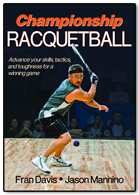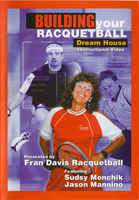 Last time, I talked about “Losing a Match and How to Bounce Back”. NO MATTER what sport pros and amateurs alike experience losing, but how to deal with the loss and learning from it makes you tougher in the long run. In this Newsletter I want to talk about “Burnout and Fighting Back” to top form.
Last time, I talked about “Losing a Match and How to Bounce Back”. NO MATTER what sport pros and amateurs alike experience losing, but how to deal with the loss and learning from it makes you tougher in the long run. In this Newsletter I want to talk about “Burnout and Fighting Back” to top form.
When you are doing too much too often while under too much stress, you may get Burned Out. Early warning signs of burnout include being short tempered, feeling extremely moody and emotional, and feeling lethargic and depressed. Take a break from racquetball, and do something different. If going to the club doesn’t seem like fun, then don’t go. Pay attention to when you need a break and a change. All work and no play brings on burnout. As human beings, we thrive on stress and recovery cycles. But the recovery has to be healthy, such as improving your diet, hydrating with water, having a massage, going to a movie, seeing good friends, listening to music, or reading a book . . . not alcohol, fast foods, and no sleep. Burnout in sport is the end result of the accumulation of piling on too much training followed by too many tournaments with no rest in between.
Intense mental or physical stress is good for you because it makes you stretch and grow. The key is to match it with the same amount of intense healthy recovery. It is in the recovery period that you actually grow. In weight training, your muscles grow at night after your strength training workout, a protein and carbohydrate meal eaten at least 90 minutes after training, and sleep. It is during your deepest sleep cycle that your muscles heal and grow. So take a good look at your recovery techniques, and make sure they are healthy.
There are many great athletes that experience burnout and fight back hard. Their careers are not over it is just a little wakeup call to slow down, adjust, and spend time recovering and recharging the battery.
Tennis players experience it as their season is so LONG as they go from the Australian Open, to the French Open, to Wimbledon and then the US Open. This year they added in the Olympics in London in July, right before the US Open, where most of them are playing. I believe Nadal losing in the 2nd round of Wimbledon this year right after winning the French Open and fairing well in Australia and playing in some mini-tournaments prior to the slams to get ready for the slam surfaces took a toll on him….burnout. When the media looked at Nadal right after his lose in Wimbledon he went home to Spain and they caught him chilling at his pool, as that is what he needed as his healthy recovery.
Rocky Carson had a grueling 1st half of the 2011/2012 season, with a two-week road trip to the Pan American Games (where he won Gold) sandwiched between back-to-back tournaments and the US Open. I believe that three to four month non-stop training/tournament schedule caused him to get burned out and he had a rough second half of the season struggling to recover from illness and just plain being tired. He really didn’t want to do anything but sleep. With a month and a half off, he did do the “healthy recovery cycle” and fought back at the end of the season still finishing with the # 2 ranking on the IRT.
Let’s examine what tools Rocky and all my athletes use to fight back after being burned out by taking a closer look at all 3 sides of The Sports Racquetball Triangle: Conditioning, Mental, and Physical Skills.
Left Side of the Triangle
Conditioning
Rest
You need to take some time off, rest, and stop overdoing it. Once you can pinpoint the problem of overtraining and being stressed out then you can go to the gym and workout starting out slowly and building yourself back up using the techniques in my book, “Championship Racquetball”, Chapter 10.
Nutrition
Eating Properly and Maintaining Energy Level
Our Nutritional Expert, Diana McNab, informs us that “burn out” can zap your energy, which is what you need on the court to perform at your best. All muscles, including the ones most used playing racquetball, need “glycogen” in order to perform at their optimal level. Glycogen is a muscle energy source that comes from fruits, vegetables and whole grains or complex carbohydrates. Your brain needs glucose or blood sugar and your entire metabolism needs water. Racquetball muscles also need “amino acids” found in protein to repair your tissues and cells. Remember, your muscles grow and heal at night after your strength training workout, a protein and carbohydrate meal eaten at least 90 minutes after training, and sleep.
Right Side of the Triangle
Mental Skills
An affirmation is a personal and present statement of what you would like to happen in your game or life. It is as if you are bringing the future into the present moment. Your mind does not know the difference between a self-created statement and reality, so it sends triggers to your body as if it is a reality now. The beauty of the mind is that you really can control so many aspects of the way it works and how it affects your game and how you play. Creating and using affirmations can be found in my book, “Championship Racquetball”, in Chapter 9.
Base of the Triangle
Physical Skills
As I said earlier, you need to take some time off, rest, figure out what is going on in your life and what is causing you to be burned out and take care of that before you keep imprinting negative habits in your game. Once you’ve identified and resolved the issue so you’re feeling better, then do the things necessary to regain your consistency level such as drilling alone, drilling with a partner, playing controlled games (working on specific shots/serves/return of serves/etc.) and then competing—playing games to win. There are various ways to drill and practice to improve in my book, “Championship Racquetball”, Chapter 8.
Once you are feeling better, don’t look back, only forge ahead.
Rocky ‘s and all my athletes “Championship Racquetball Games” stem from their focus on ALL 3 sides of the triangle working together so they can develop into top competitors. Without a shadow of a doubt, they KNOW just how important it is to do the work. They are living proof it works and their titles substantiate it. Those that know how to deal with loss and bouncing back to excellent form are Rocky, Paola, Taylor and Sharon. It comes from lots of hard work in every aspect of the Sports Racquetball Triangle. It is not by accident Rocky has been the #2 IRT Player, Paola has been the #1 WPRO Player for the past se years, and Taylor and Sharon are marching up the Pro Ranks.
Next issue I will continue to build your Championship Racquetball Game one level at a time so you too can be ready to become the champion you always dreamed of, but now you will have the tools to do it and make it a reality.
For details on more personalized instruction, a weekend camp, instructional DVD’s, our book, “Championship Racquetball,” which covers all aspects of the Sports Racquetball Triangle and more, please visit www.FranDavisRacquetball.com.
Fran Davis is a 2004 racquetball Hall of Fame inductee, Racquetball Woman of the Year 2009, Coach #2 IRT Pro Player, Rocky Carson; Coach #1 Women’s Pro Player, Paola Longoria; Coach Jr. World & National Champion, Intercollegiate Champion, & #16 IRT Pro Player, Taylor Knoth; Coach Intercollegiate Champion & #19 WPRO Pro Player, Sharon Jackson; Master Professional Instructor/Coach USAR-IP. International Racquetball Tour.










